Impact of Competitiveness on Consumer Purchasing Behavior in Fashion
VerifiedAdded on 2022/10/17
|49
|9754
|110
Report
AI Summary
This report investigates the impact of competitiveness on consumer purchasing behavior within the Australian fashion industry, focusing on Desigual. It explores the significance of increasing competitiveness, challenges faced, and factors affecting consumer satisfaction. The research analyzes the Australian fashion industry's revenue, employment, and the impact of online sales and fashion trends. The study aims to analyze the challenges faced by the Australian fashion industry and evaluate the factors which impact the market competitiveness along with their impact on consumer satisfaction. The report also reviews the changing local capacity, including the role of imports and local manufacturing, and the importance of intellectual property. The methodology includes data analysis to identify relationships between consumer satisfaction and Desigual's strategies, such as promoting feedback, introducing fashion trends, increasing online sales, and sustainability initiatives. The findings reveal insights into consumer behavior, challenges, and provide recommendations for Desigual to enhance competitiveness, improve consumer satisfaction, and adapt to market trends. The report concludes with limitations and suggestions for future research in this dynamic industry.
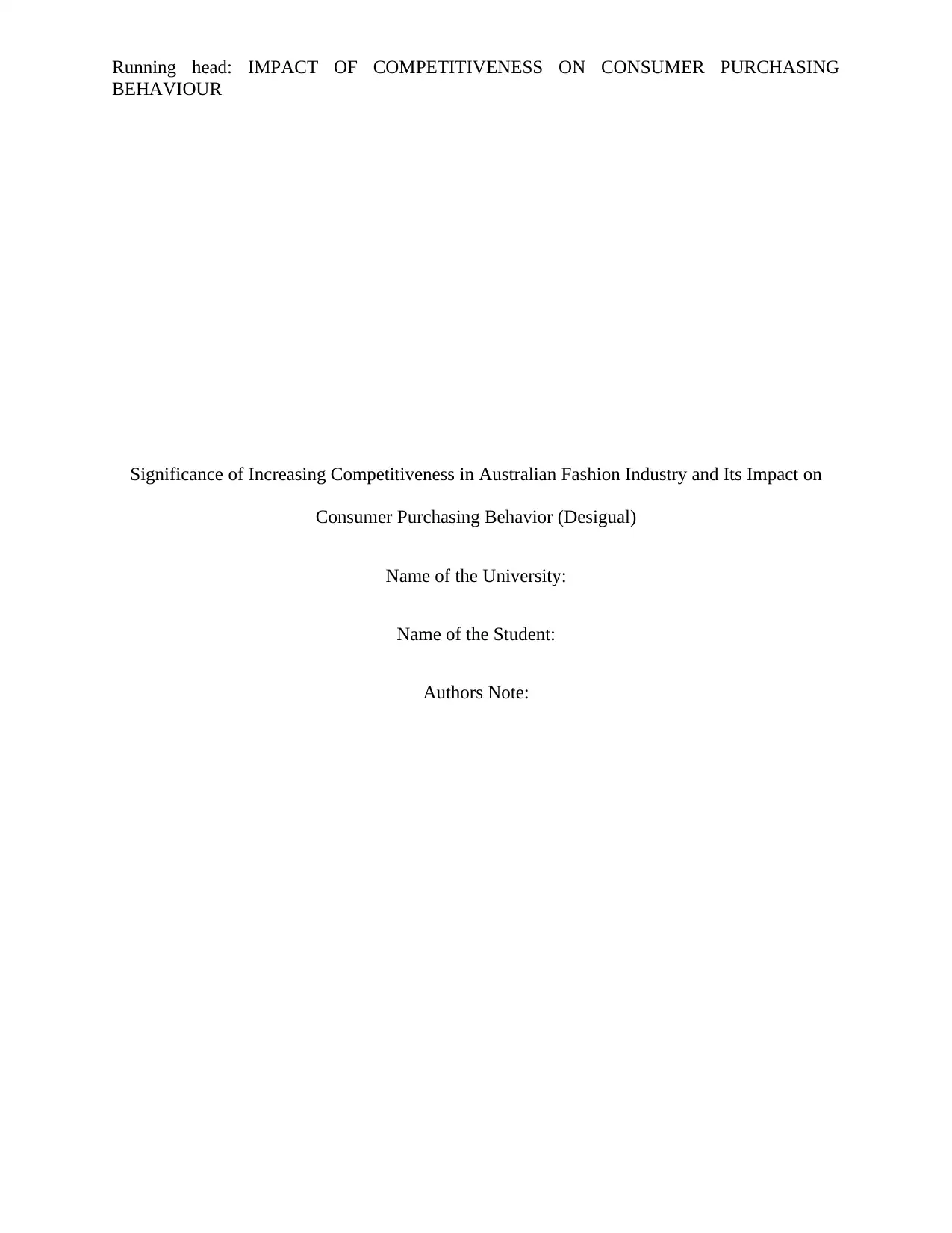
Running head: IMPACT OF COMPETITIVENESS ON CONSUMER PURCHASING
BEHAVIOUR
Significance of Increasing Competitiveness in Australian Fashion Industry and Its Impact on
Consumer Purchasing Behavior (Desigual)
Name of the University:
Name of the Student:
Authors Note:
BEHAVIOUR
Significance of Increasing Competitiveness in Australian Fashion Industry and Its Impact on
Consumer Purchasing Behavior (Desigual)
Name of the University:
Name of the Student:
Authors Note:
Paraphrase This Document
Need a fresh take? Get an instant paraphrase of this document with our AI Paraphraser
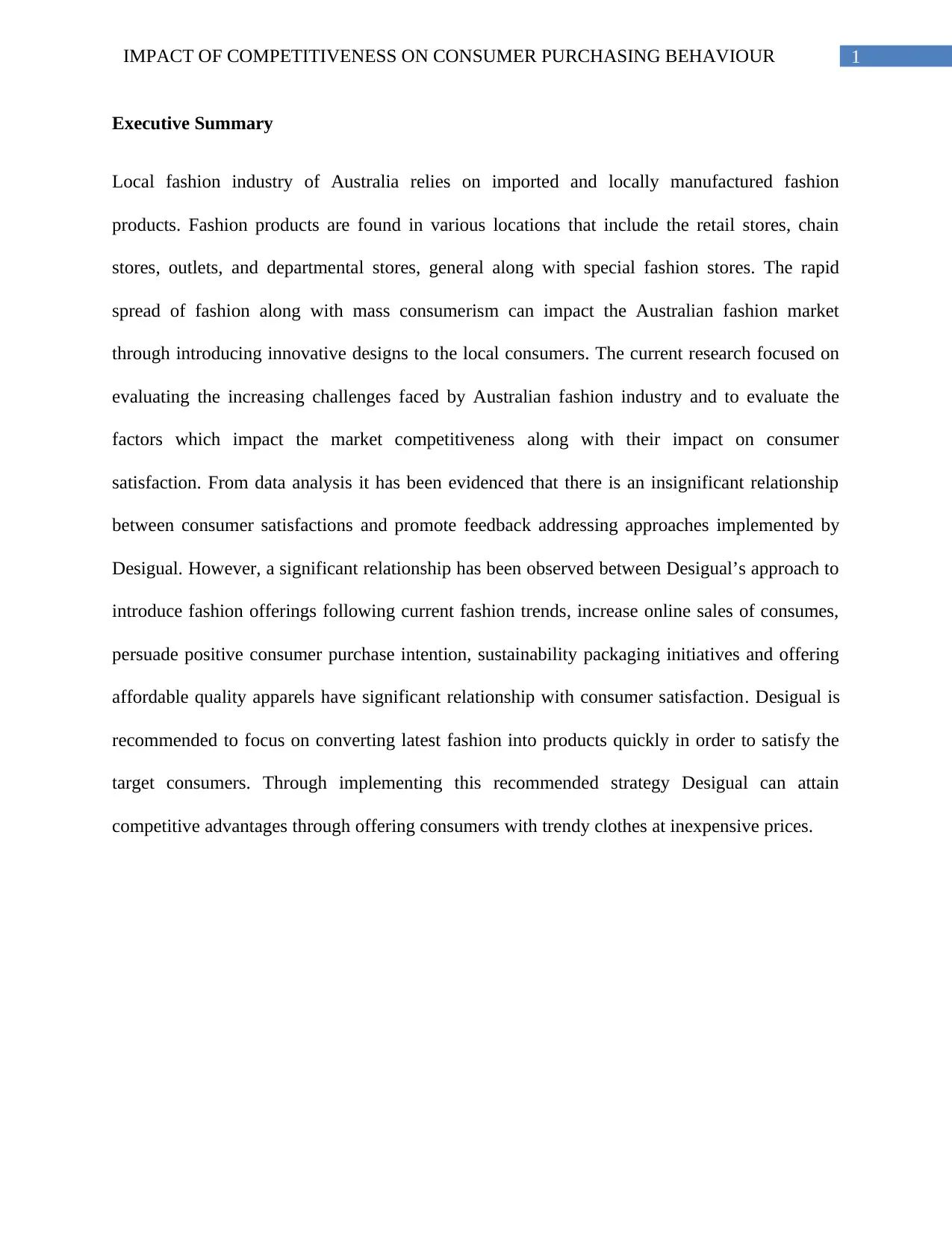
1IMPACT OF COMPETITIVENESS ON CONSUMER PURCHASING BEHAVIOUR
Executive Summary
Local fashion industry of Australia relies on imported and locally manufactured fashion
products. Fashion products are found in various locations that include the retail stores, chain
stores, outlets, and departmental stores, general along with special fashion stores. The rapid
spread of fashion along with mass consumerism can impact the Australian fashion market
through introducing innovative designs to the local consumers. The current research focused on
evaluating the increasing challenges faced by Australian fashion industry and to evaluate the
factors which impact the market competitiveness along with their impact on consumer
satisfaction. From data analysis it has been evidenced that there is an insignificant relationship
between consumer satisfactions and promote feedback addressing approaches implemented by
Desigual. However, a significant relationship has been observed between Desigual’s approach to
introduce fashion offerings following current fashion trends, increase online sales of consumes,
persuade positive consumer purchase intention, sustainability packaging initiatives and offering
affordable quality apparels have significant relationship with consumer satisfaction. Desigual is
recommended to focus on converting latest fashion into products quickly in order to satisfy the
target consumers. Through implementing this recommended strategy Desigual can attain
competitive advantages through offering consumers with trendy clothes at inexpensive prices.
Executive Summary
Local fashion industry of Australia relies on imported and locally manufactured fashion
products. Fashion products are found in various locations that include the retail stores, chain
stores, outlets, and departmental stores, general along with special fashion stores. The rapid
spread of fashion along with mass consumerism can impact the Australian fashion market
through introducing innovative designs to the local consumers. The current research focused on
evaluating the increasing challenges faced by Australian fashion industry and to evaluate the
factors which impact the market competitiveness along with their impact on consumer
satisfaction. From data analysis it has been evidenced that there is an insignificant relationship
between consumer satisfactions and promote feedback addressing approaches implemented by
Desigual. However, a significant relationship has been observed between Desigual’s approach to
introduce fashion offerings following current fashion trends, increase online sales of consumes,
persuade positive consumer purchase intention, sustainability packaging initiatives and offering
affordable quality apparels have significant relationship with consumer satisfaction. Desigual is
recommended to focus on converting latest fashion into products quickly in order to satisfy the
target consumers. Through implementing this recommended strategy Desigual can attain
competitive advantages through offering consumers with trendy clothes at inexpensive prices.
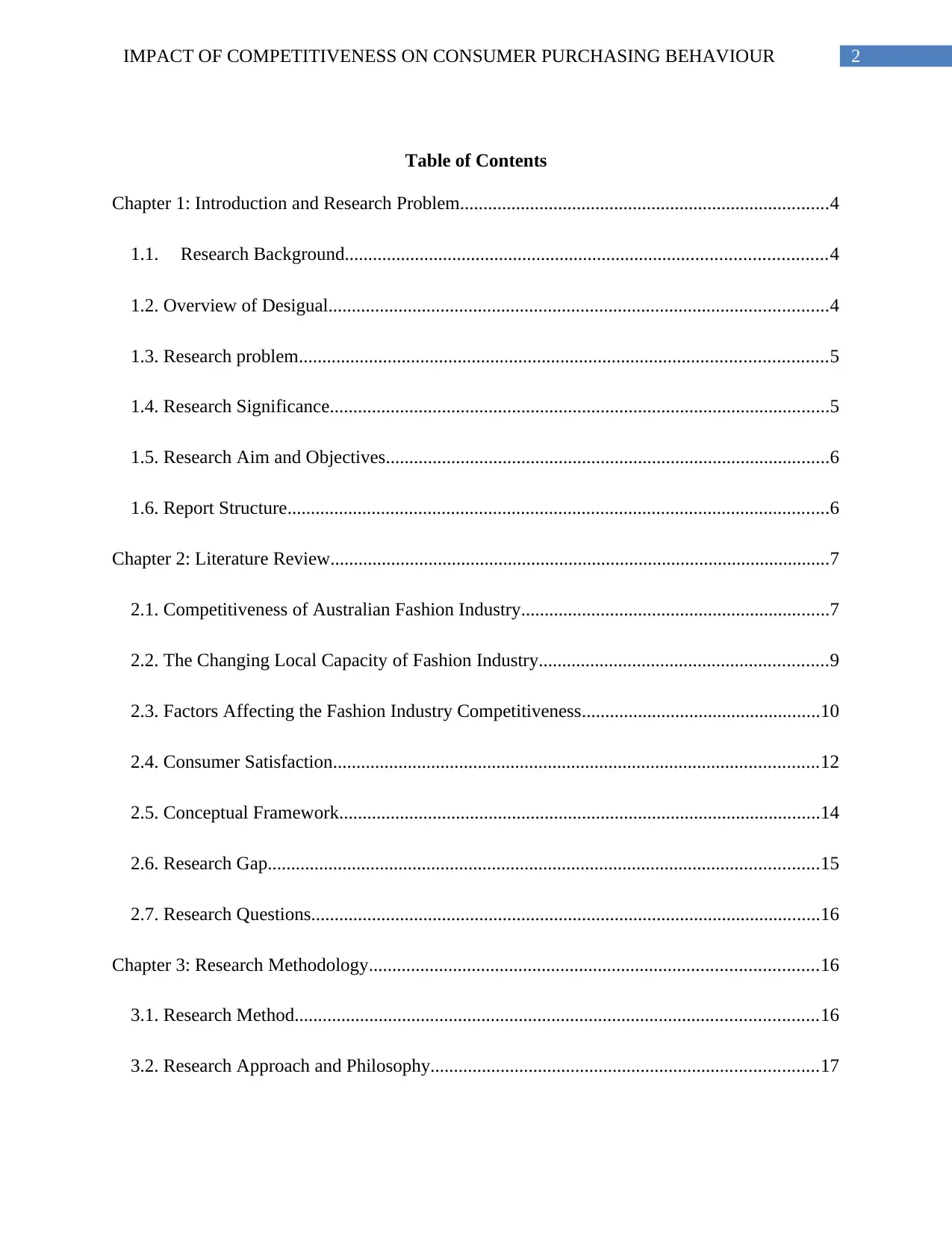
2IMPACT OF COMPETITIVENESS ON CONSUMER PURCHASING BEHAVIOUR
Table of Contents
Chapter 1: Introduction and Research Problem...............................................................................4
1.1. Research Background.......................................................................................................4
1.2. Overview of Desigual...........................................................................................................4
1.3. Research problem.................................................................................................................5
1.4. Research Significance...........................................................................................................5
1.5. Research Aim and Objectives...............................................................................................6
1.6. Report Structure....................................................................................................................6
Chapter 2: Literature Review...........................................................................................................7
2.1. Competitiveness of Australian Fashion Industry..................................................................7
2.2. The Changing Local Capacity of Fashion Industry..............................................................9
2.3. Factors Affecting the Fashion Industry Competitiveness...................................................10
2.4. Consumer Satisfaction........................................................................................................12
2.5. Conceptual Framework.......................................................................................................14
2.6. Research Gap......................................................................................................................15
2.7. Research Questions.............................................................................................................16
Chapter 3: Research Methodology................................................................................................16
3.1. Research Method................................................................................................................16
3.2. Research Approach and Philosophy...................................................................................17
Table of Contents
Chapter 1: Introduction and Research Problem...............................................................................4
1.1. Research Background.......................................................................................................4
1.2. Overview of Desigual...........................................................................................................4
1.3. Research problem.................................................................................................................5
1.4. Research Significance...........................................................................................................5
1.5. Research Aim and Objectives...............................................................................................6
1.6. Report Structure....................................................................................................................6
Chapter 2: Literature Review...........................................................................................................7
2.1. Competitiveness of Australian Fashion Industry..................................................................7
2.2. The Changing Local Capacity of Fashion Industry..............................................................9
2.3. Factors Affecting the Fashion Industry Competitiveness...................................................10
2.4. Consumer Satisfaction........................................................................................................12
2.5. Conceptual Framework.......................................................................................................14
2.6. Research Gap......................................................................................................................15
2.7. Research Questions.............................................................................................................16
Chapter 3: Research Methodology................................................................................................16
3.1. Research Method................................................................................................................16
3.2. Research Approach and Philosophy...................................................................................17
⊘ This is a preview!⊘
Do you want full access?
Subscribe today to unlock all pages.

Trusted by 1+ million students worldwide
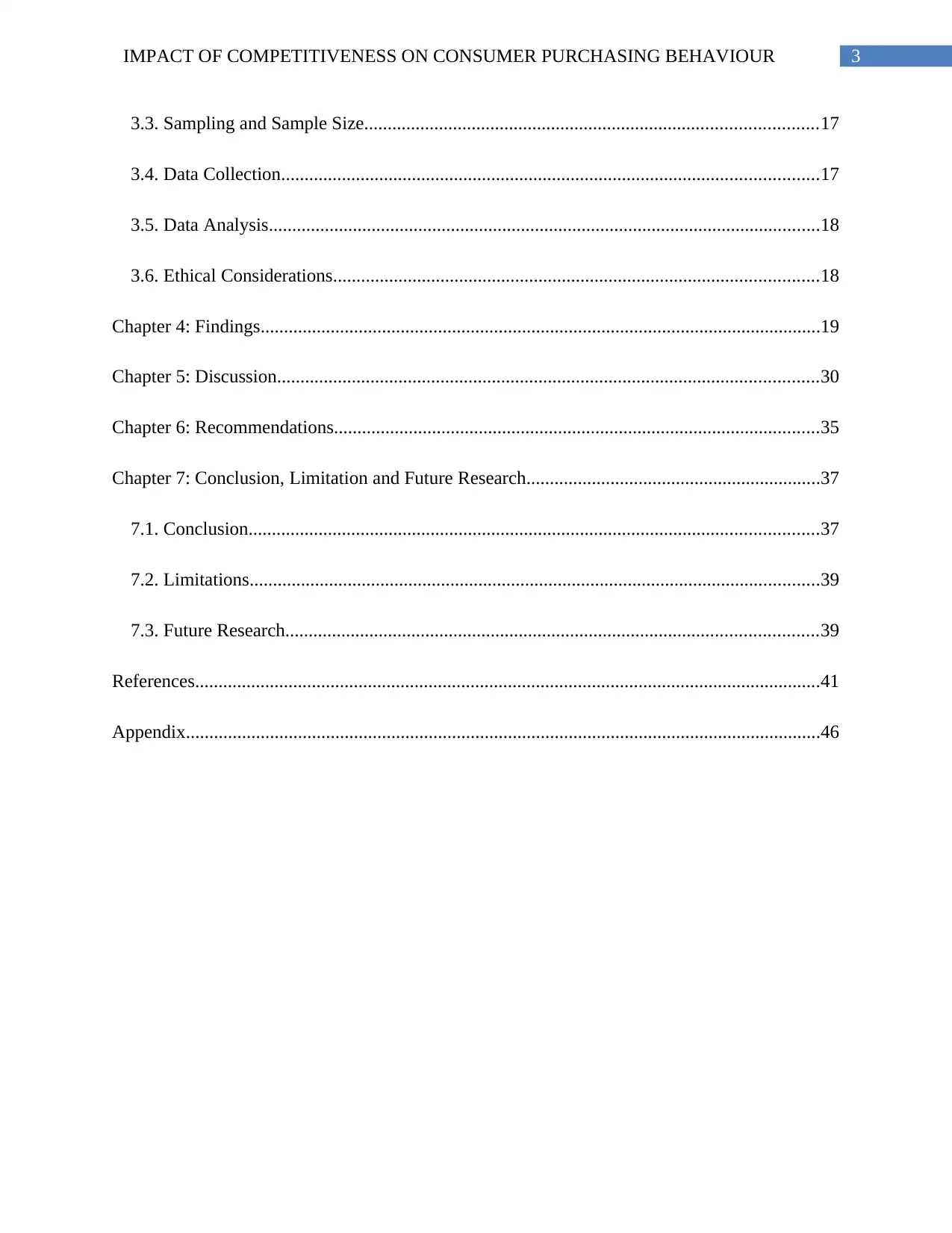
3IMPACT OF COMPETITIVENESS ON CONSUMER PURCHASING BEHAVIOUR
3.3. Sampling and Sample Size.................................................................................................17
3.4. Data Collection...................................................................................................................17
3.5. Data Analysis......................................................................................................................18
3.6. Ethical Considerations........................................................................................................18
Chapter 4: Findings........................................................................................................................19
Chapter 5: Discussion....................................................................................................................30
Chapter 6: Recommendations........................................................................................................35
Chapter 7: Conclusion, Limitation and Future Research...............................................................37
7.1. Conclusion..........................................................................................................................37
7.2. Limitations..........................................................................................................................39
7.3. Future Research..................................................................................................................39
References......................................................................................................................................41
Appendix........................................................................................................................................46
3.3. Sampling and Sample Size.................................................................................................17
3.4. Data Collection...................................................................................................................17
3.5. Data Analysis......................................................................................................................18
3.6. Ethical Considerations........................................................................................................18
Chapter 4: Findings........................................................................................................................19
Chapter 5: Discussion....................................................................................................................30
Chapter 6: Recommendations........................................................................................................35
Chapter 7: Conclusion, Limitation and Future Research...............................................................37
7.1. Conclusion..........................................................................................................................37
7.2. Limitations..........................................................................................................................39
7.3. Future Research..................................................................................................................39
References......................................................................................................................................41
Appendix........................................................................................................................................46
Paraphrase This Document
Need a fresh take? Get an instant paraphrase of this document with our AI Paraphraser
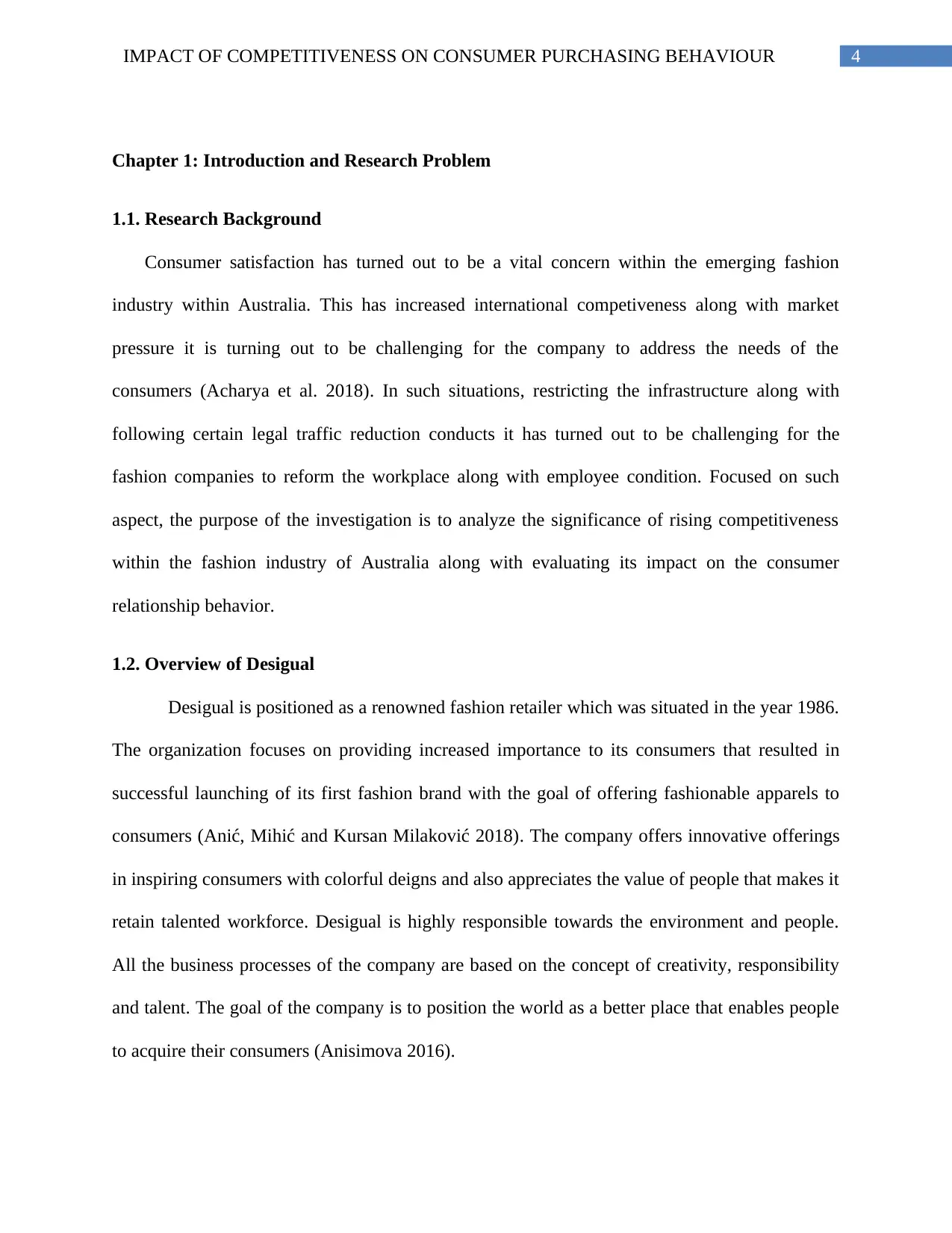
4IMPACT OF COMPETITIVENESS ON CONSUMER PURCHASING BEHAVIOUR
Chapter 1: Introduction and Research Problem
1.1. Research Background
Consumer satisfaction has turned out to be a vital concern within the emerging fashion
industry within Australia. This has increased international competiveness along with market
pressure it is turning out to be challenging for the company to address the needs of the
consumers (Acharya et al. 2018). In such situations, restricting the infrastructure along with
following certain legal traffic reduction conducts it has turned out to be challenging for the
fashion companies to reform the workplace along with employee condition. Focused on such
aspect, the purpose of the investigation is to analyze the significance of rising competitiveness
within the fashion industry of Australia along with evaluating its impact on the consumer
relationship behavior.
1.2. Overview of Desigual
Desigual is positioned as a renowned fashion retailer which was situated in the year 1986.
The organization focuses on providing increased importance to its consumers that resulted in
successful launching of its first fashion brand with the goal of offering fashionable apparels to
consumers (Anić, Mihić and Kursan Milaković 2018). The company offers innovative offerings
in inspiring consumers with colorful deigns and also appreciates the value of people that makes it
retain talented workforce. Desigual is highly responsible towards the environment and people.
All the business processes of the company are based on the concept of creativity, responsibility
and talent. The goal of the company is to position the world as a better place that enables people
to acquire their consumers (Anisimova 2016).
Chapter 1: Introduction and Research Problem
1.1. Research Background
Consumer satisfaction has turned out to be a vital concern within the emerging fashion
industry within Australia. This has increased international competiveness along with market
pressure it is turning out to be challenging for the company to address the needs of the
consumers (Acharya et al. 2018). In such situations, restricting the infrastructure along with
following certain legal traffic reduction conducts it has turned out to be challenging for the
fashion companies to reform the workplace along with employee condition. Focused on such
aspect, the purpose of the investigation is to analyze the significance of rising competitiveness
within the fashion industry of Australia along with evaluating its impact on the consumer
relationship behavior.
1.2. Overview of Desigual
Desigual is positioned as a renowned fashion retailer which was situated in the year 1986.
The organization focuses on providing increased importance to its consumers that resulted in
successful launching of its first fashion brand with the goal of offering fashionable apparels to
consumers (Anić, Mihić and Kursan Milaković 2018). The company offers innovative offerings
in inspiring consumers with colorful deigns and also appreciates the value of people that makes it
retain talented workforce. Desigual is highly responsible towards the environment and people.
All the business processes of the company are based on the concept of creativity, responsibility
and talent. The goal of the company is to position the world as a better place that enables people
to acquire their consumers (Anisimova 2016).
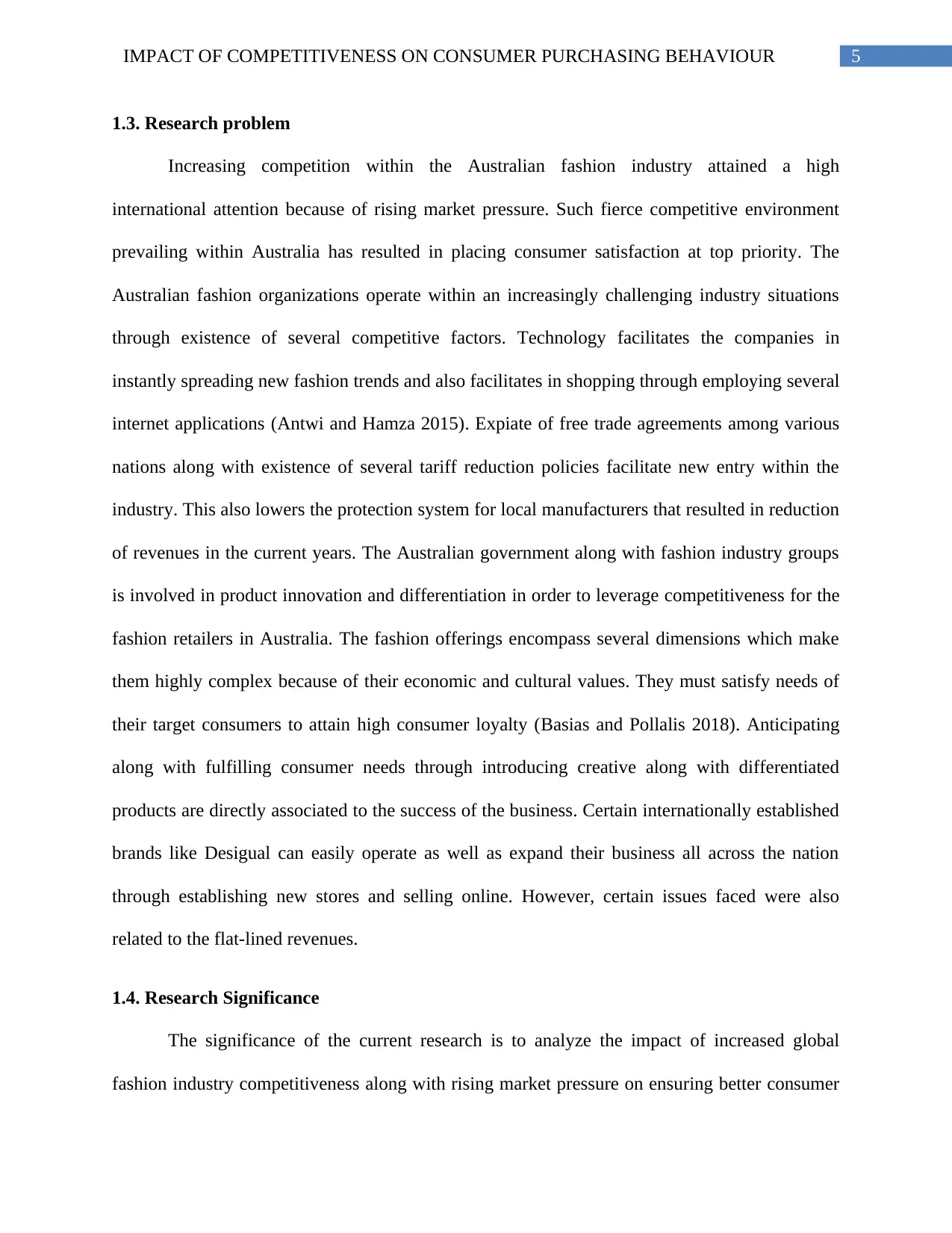
5IMPACT OF COMPETITIVENESS ON CONSUMER PURCHASING BEHAVIOUR
1.3. Research problem
Increasing competition within the Australian fashion industry attained a high
international attention because of rising market pressure. Such fierce competitive environment
prevailing within Australia has resulted in placing consumer satisfaction at top priority. The
Australian fashion organizations operate within an increasingly challenging industry situations
through existence of several competitive factors. Technology facilitates the companies in
instantly spreading new fashion trends and also facilitates in shopping through employing several
internet applications (Antwi and Hamza 2015). Expiate of free trade agreements among various
nations along with existence of several tariff reduction policies facilitate new entry within the
industry. This also lowers the protection system for local manufacturers that resulted in reduction
of revenues in the current years. The Australian government along with fashion industry groups
is involved in product innovation and differentiation in order to leverage competitiveness for the
fashion retailers in Australia. The fashion offerings encompass several dimensions which make
them highly complex because of their economic and cultural values. They must satisfy needs of
their target consumers to attain high consumer loyalty (Basias and Pollalis 2018). Anticipating
along with fulfilling consumer needs through introducing creative along with differentiated
products are directly associated to the success of the business. Certain internationally established
brands like Desigual can easily operate as well as expand their business all across the nation
through establishing new stores and selling online. However, certain issues faced were also
related to the flat-lined revenues.
1.4. Research Significance
The significance of the current research is to analyze the impact of increased global
fashion industry competitiveness along with rising market pressure on ensuring better consumer
1.3. Research problem
Increasing competition within the Australian fashion industry attained a high
international attention because of rising market pressure. Such fierce competitive environment
prevailing within Australia has resulted in placing consumer satisfaction at top priority. The
Australian fashion organizations operate within an increasingly challenging industry situations
through existence of several competitive factors. Technology facilitates the companies in
instantly spreading new fashion trends and also facilitates in shopping through employing several
internet applications (Antwi and Hamza 2015). Expiate of free trade agreements among various
nations along with existence of several tariff reduction policies facilitate new entry within the
industry. This also lowers the protection system for local manufacturers that resulted in reduction
of revenues in the current years. The Australian government along with fashion industry groups
is involved in product innovation and differentiation in order to leverage competitiveness for the
fashion retailers in Australia. The fashion offerings encompass several dimensions which make
them highly complex because of their economic and cultural values. They must satisfy needs of
their target consumers to attain high consumer loyalty (Basias and Pollalis 2018). Anticipating
along with fulfilling consumer needs through introducing creative along with differentiated
products are directly associated to the success of the business. Certain internationally established
brands like Desigual can easily operate as well as expand their business all across the nation
through establishing new stores and selling online. However, certain issues faced were also
related to the flat-lined revenues.
1.4. Research Significance
The significance of the current research is to analyze the impact of increased global
fashion industry competitiveness along with rising market pressure on ensuring better consumer
⊘ This is a preview!⊘
Do you want full access?
Subscribe today to unlock all pages.

Trusted by 1+ million students worldwide
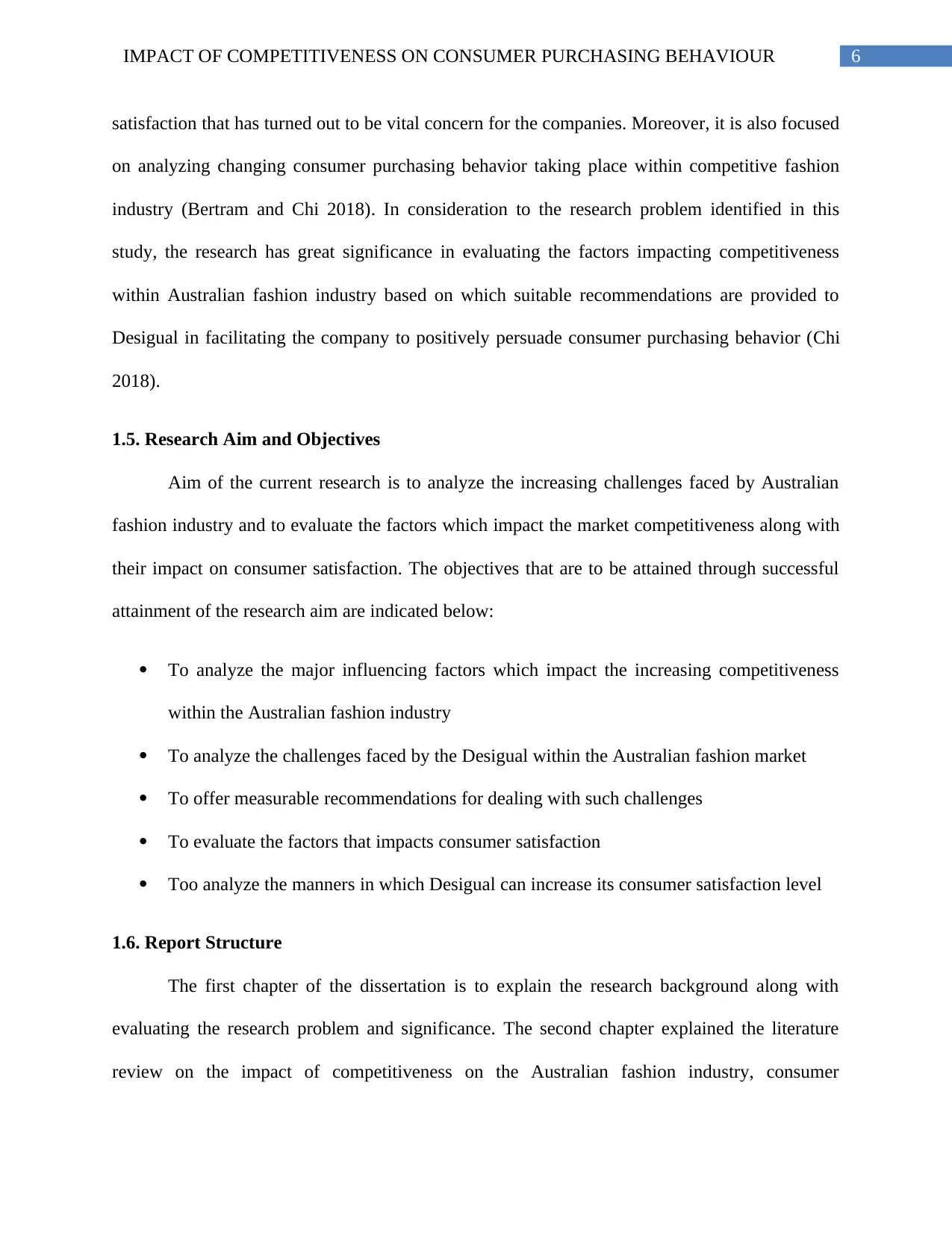
6IMPACT OF COMPETITIVENESS ON CONSUMER PURCHASING BEHAVIOUR
satisfaction that has turned out to be vital concern for the companies. Moreover, it is also focused
on analyzing changing consumer purchasing behavior taking place within competitive fashion
industry (Bertram and Chi 2018). In consideration to the research problem identified in this
study, the research has great significance in evaluating the factors impacting competitiveness
within Australian fashion industry based on which suitable recommendations are provided to
Desigual in facilitating the company to positively persuade consumer purchasing behavior (Chi
2018).
1.5. Research Aim and Objectives
Aim of the current research is to analyze the increasing challenges faced by Australian
fashion industry and to evaluate the factors which impact the market competitiveness along with
their impact on consumer satisfaction. The objectives that are to be attained through successful
attainment of the research aim are indicated below:
To analyze the major influencing factors which impact the increasing competitiveness
within the Australian fashion industry
To analyze the challenges faced by the Desigual within the Australian fashion market
To offer measurable recommendations for dealing with such challenges
To evaluate the factors that impacts consumer satisfaction
Too analyze the manners in which Desigual can increase its consumer satisfaction level
1.6. Report Structure
The first chapter of the dissertation is to explain the research background along with
evaluating the research problem and significance. The second chapter explained the literature
review on the impact of competitiveness on the Australian fashion industry, consumer
satisfaction that has turned out to be vital concern for the companies. Moreover, it is also focused
on analyzing changing consumer purchasing behavior taking place within competitive fashion
industry (Bertram and Chi 2018). In consideration to the research problem identified in this
study, the research has great significance in evaluating the factors impacting competitiveness
within Australian fashion industry based on which suitable recommendations are provided to
Desigual in facilitating the company to positively persuade consumer purchasing behavior (Chi
2018).
1.5. Research Aim and Objectives
Aim of the current research is to analyze the increasing challenges faced by Australian
fashion industry and to evaluate the factors which impact the market competitiveness along with
their impact on consumer satisfaction. The objectives that are to be attained through successful
attainment of the research aim are indicated below:
To analyze the major influencing factors which impact the increasing competitiveness
within the Australian fashion industry
To analyze the challenges faced by the Desigual within the Australian fashion market
To offer measurable recommendations for dealing with such challenges
To evaluate the factors that impacts consumer satisfaction
Too analyze the manners in which Desigual can increase its consumer satisfaction level
1.6. Report Structure
The first chapter of the dissertation is to explain the research background along with
evaluating the research problem and significance. The second chapter explained the literature
review on the impact of competitiveness on the Australian fashion industry, consumer
Paraphrase This Document
Need a fresh take? Get an instant paraphrase of this document with our AI Paraphraser
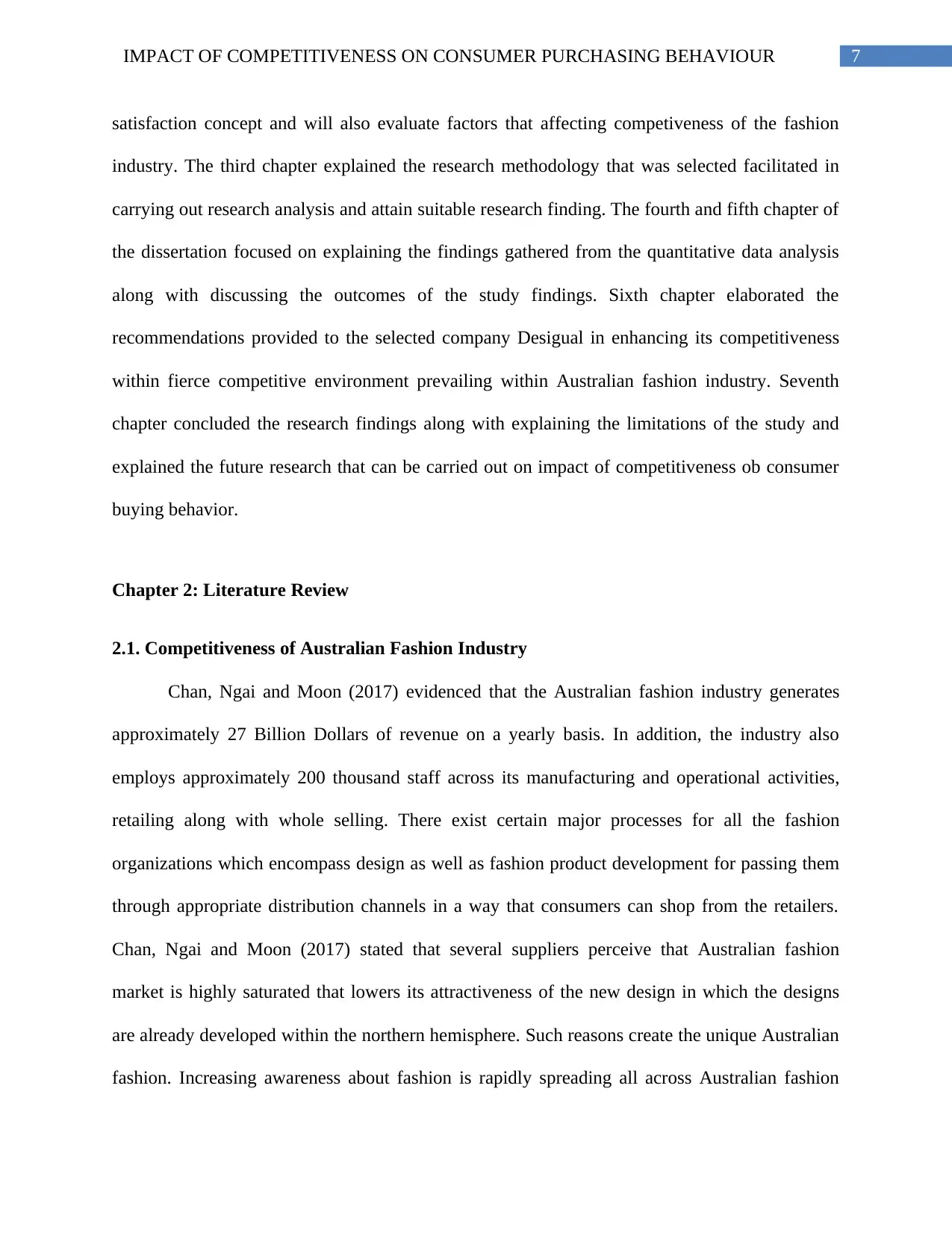
7IMPACT OF COMPETITIVENESS ON CONSUMER PURCHASING BEHAVIOUR
satisfaction concept and will also evaluate factors that affecting competiveness of the fashion
industry. The third chapter explained the research methodology that was selected facilitated in
carrying out research analysis and attain suitable research finding. The fourth and fifth chapter of
the dissertation focused on explaining the findings gathered from the quantitative data analysis
along with discussing the outcomes of the study findings. Sixth chapter elaborated the
recommendations provided to the selected company Desigual in enhancing its competitiveness
within fierce competitive environment prevailing within Australian fashion industry. Seventh
chapter concluded the research findings along with explaining the limitations of the study and
explained the future research that can be carried out on impact of competitiveness ob consumer
buying behavior.
Chapter 2: Literature Review
2.1. Competitiveness of Australian Fashion Industry
Chan, Ngai and Moon (2017) evidenced that the Australian fashion industry generates
approximately 27 Billion Dollars of revenue on a yearly basis. In addition, the industry also
employs approximately 200 thousand staff across its manufacturing and operational activities,
retailing along with whole selling. There exist certain major processes for all the fashion
organizations which encompass design as well as fashion product development for passing them
through appropriate distribution channels in a way that consumers can shop from the retailers.
Chan, Ngai and Moon (2017) stated that several suppliers perceive that Australian fashion
market is highly saturated that lowers its attractiveness of the new design in which the designs
are already developed within the northern hemisphere. Such reasons create the unique Australian
fashion. Increasing awareness about fashion is rapidly spreading all across Australian fashion
satisfaction concept and will also evaluate factors that affecting competiveness of the fashion
industry. The third chapter explained the research methodology that was selected facilitated in
carrying out research analysis and attain suitable research finding. The fourth and fifth chapter of
the dissertation focused on explaining the findings gathered from the quantitative data analysis
along with discussing the outcomes of the study findings. Sixth chapter elaborated the
recommendations provided to the selected company Desigual in enhancing its competitiveness
within fierce competitive environment prevailing within Australian fashion industry. Seventh
chapter concluded the research findings along with explaining the limitations of the study and
explained the future research that can be carried out on impact of competitiveness ob consumer
buying behavior.
Chapter 2: Literature Review
2.1. Competitiveness of Australian Fashion Industry
Chan, Ngai and Moon (2017) evidenced that the Australian fashion industry generates
approximately 27 Billion Dollars of revenue on a yearly basis. In addition, the industry also
employs approximately 200 thousand staff across its manufacturing and operational activities,
retailing along with whole selling. There exist certain major processes for all the fashion
organizations which encompass design as well as fashion product development for passing them
through appropriate distribution channels in a way that consumers can shop from the retailers.
Chan, Ngai and Moon (2017) stated that several suppliers perceive that Australian fashion
market is highly saturated that lowers its attractiveness of the new design in which the designs
are already developed within the northern hemisphere. Such reasons create the unique Australian
fashion. Increasing awareness about fashion is rapidly spreading all across Australian fashion
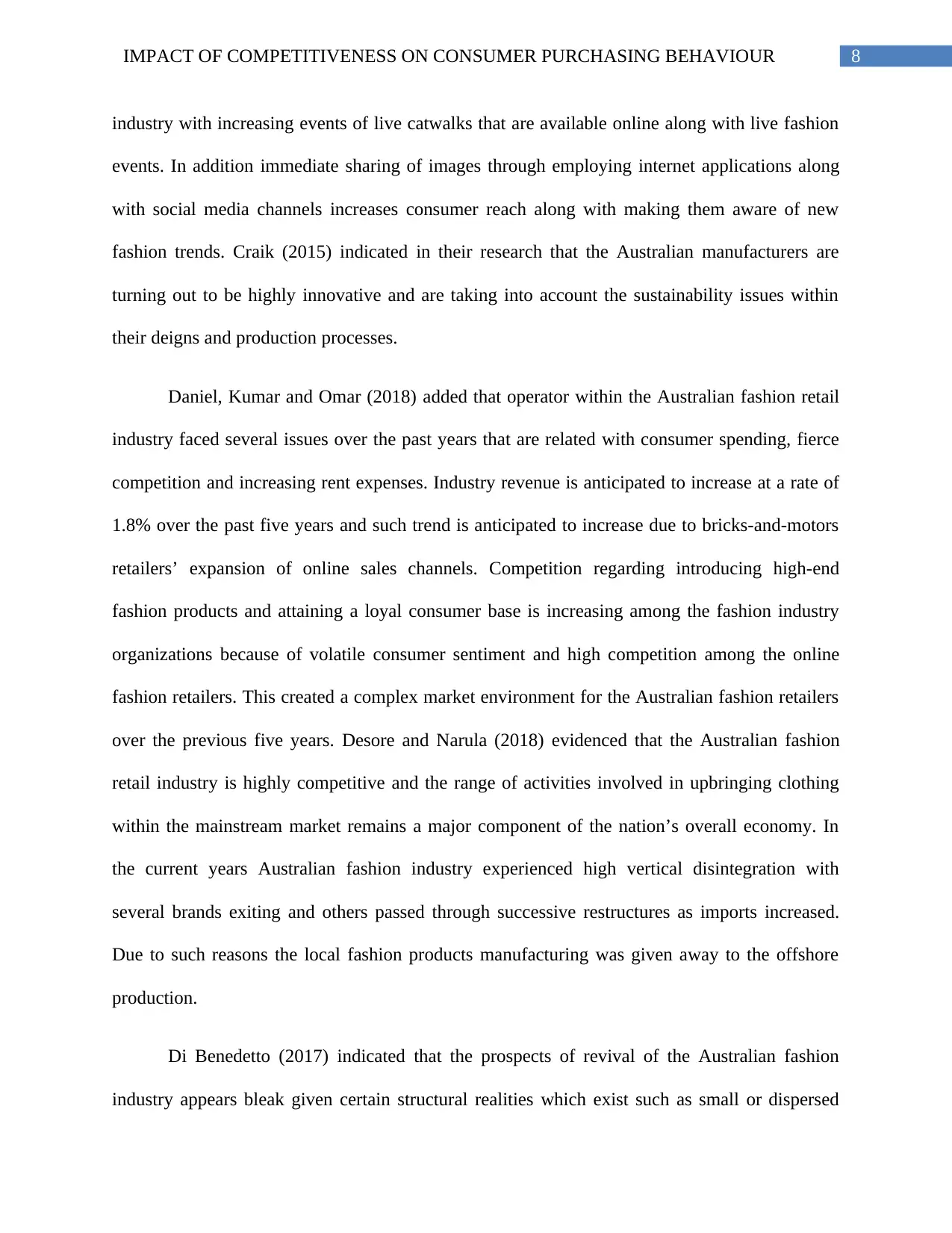
8IMPACT OF COMPETITIVENESS ON CONSUMER PURCHASING BEHAVIOUR
industry with increasing events of live catwalks that are available online along with live fashion
events. In addition immediate sharing of images through employing internet applications along
with social media channels increases consumer reach along with making them aware of new
fashion trends. Craik (2015) indicated in their research that the Australian manufacturers are
turning out to be highly innovative and are taking into account the sustainability issues within
their deigns and production processes.
Daniel, Kumar and Omar (2018) added that operator within the Australian fashion retail
industry faced several issues over the past years that are related with consumer spending, fierce
competition and increasing rent expenses. Industry revenue is anticipated to increase at a rate of
1.8% over the past five years and such trend is anticipated to increase due to bricks-and-motors
retailers’ expansion of online sales channels. Competition regarding introducing high-end
fashion products and attaining a loyal consumer base is increasing among the fashion industry
organizations because of volatile consumer sentiment and high competition among the online
fashion retailers. This created a complex market environment for the Australian fashion retailers
over the previous five years. Desore and Narula (2018) evidenced that the Australian fashion
retail industry is highly competitive and the range of activities involved in upbringing clothing
within the mainstream market remains a major component of the nation’s overall economy. In
the current years Australian fashion industry experienced high vertical disintegration with
several brands exiting and others passed through successive restructures as imports increased.
Due to such reasons the local fashion products manufacturing was given away to the offshore
production.
Di Benedetto (2017) indicated that the prospects of revival of the Australian fashion
industry appears bleak given certain structural realities which exist such as small or dispersed
industry with increasing events of live catwalks that are available online along with live fashion
events. In addition immediate sharing of images through employing internet applications along
with social media channels increases consumer reach along with making them aware of new
fashion trends. Craik (2015) indicated in their research that the Australian manufacturers are
turning out to be highly innovative and are taking into account the sustainability issues within
their deigns and production processes.
Daniel, Kumar and Omar (2018) added that operator within the Australian fashion retail
industry faced several issues over the past years that are related with consumer spending, fierce
competition and increasing rent expenses. Industry revenue is anticipated to increase at a rate of
1.8% over the past five years and such trend is anticipated to increase due to bricks-and-motors
retailers’ expansion of online sales channels. Competition regarding introducing high-end
fashion products and attaining a loyal consumer base is increasing among the fashion industry
organizations because of volatile consumer sentiment and high competition among the online
fashion retailers. This created a complex market environment for the Australian fashion retailers
over the previous five years. Desore and Narula (2018) evidenced that the Australian fashion
retail industry is highly competitive and the range of activities involved in upbringing clothing
within the mainstream market remains a major component of the nation’s overall economy. In
the current years Australian fashion industry experienced high vertical disintegration with
several brands exiting and others passed through successive restructures as imports increased.
Due to such reasons the local fashion products manufacturing was given away to the offshore
production.
Di Benedetto (2017) indicated that the prospects of revival of the Australian fashion
industry appears bleak given certain structural realities which exist such as small or dispersed
⊘ This is a preview!⊘
Do you want full access?
Subscribe today to unlock all pages.

Trusted by 1+ million students worldwide
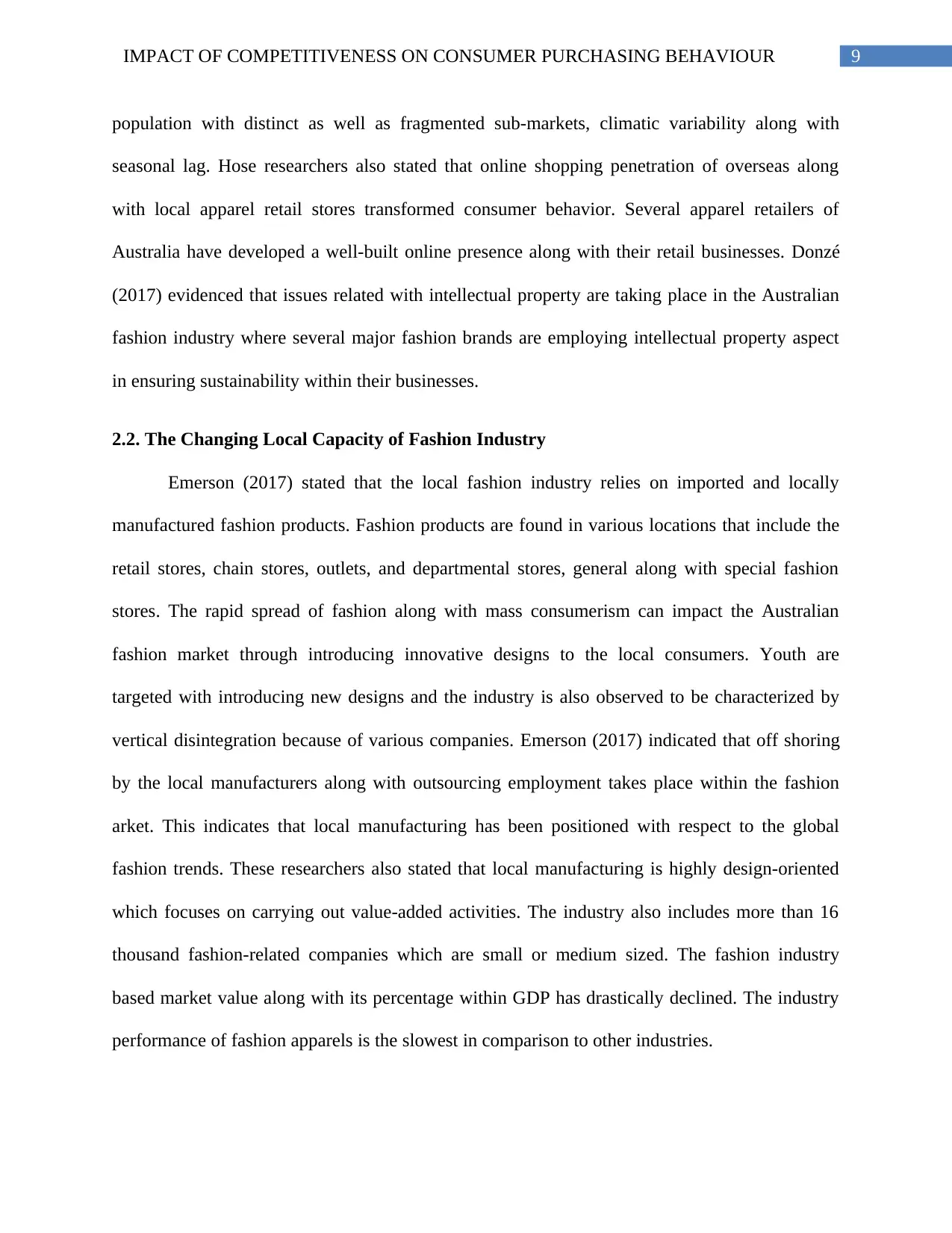
9IMPACT OF COMPETITIVENESS ON CONSUMER PURCHASING BEHAVIOUR
population with distinct as well as fragmented sub-markets, climatic variability along with
seasonal lag. Hose researchers also stated that online shopping penetration of overseas along
with local apparel retail stores transformed consumer behavior. Several apparel retailers of
Australia have developed a well-built online presence along with their retail businesses. Donzé
(2017) evidenced that issues related with intellectual property are taking place in the Australian
fashion industry where several major fashion brands are employing intellectual property aspect
in ensuring sustainability within their businesses.
2.2. The Changing Local Capacity of Fashion Industry
Emerson (2017) stated that the local fashion industry relies on imported and locally
manufactured fashion products. Fashion products are found in various locations that include the
retail stores, chain stores, outlets, and departmental stores, general along with special fashion
stores. The rapid spread of fashion along with mass consumerism can impact the Australian
fashion market through introducing innovative designs to the local consumers. Youth are
targeted with introducing new designs and the industry is also observed to be characterized by
vertical disintegration because of various companies. Emerson (2017) indicated that off shoring
by the local manufacturers along with outsourcing employment takes place within the fashion
arket. This indicates that local manufacturing has been positioned with respect to the global
fashion trends. These researchers also stated that local manufacturing is highly design-oriented
which focuses on carrying out value-added activities. The industry also includes more than 16
thousand fashion-related companies which are small or medium sized. The fashion industry
based market value along with its percentage within GDP has drastically declined. The industry
performance of fashion apparels is the slowest in comparison to other industries.
population with distinct as well as fragmented sub-markets, climatic variability along with
seasonal lag. Hose researchers also stated that online shopping penetration of overseas along
with local apparel retail stores transformed consumer behavior. Several apparel retailers of
Australia have developed a well-built online presence along with their retail businesses. Donzé
(2017) evidenced that issues related with intellectual property are taking place in the Australian
fashion industry where several major fashion brands are employing intellectual property aspect
in ensuring sustainability within their businesses.
2.2. The Changing Local Capacity of Fashion Industry
Emerson (2017) stated that the local fashion industry relies on imported and locally
manufactured fashion products. Fashion products are found in various locations that include the
retail stores, chain stores, outlets, and departmental stores, general along with special fashion
stores. The rapid spread of fashion along with mass consumerism can impact the Australian
fashion market through introducing innovative designs to the local consumers. Youth are
targeted with introducing new designs and the industry is also observed to be characterized by
vertical disintegration because of various companies. Emerson (2017) indicated that off shoring
by the local manufacturers along with outsourcing employment takes place within the fashion
arket. This indicates that local manufacturing has been positioned with respect to the global
fashion trends. These researchers also stated that local manufacturing is highly design-oriented
which focuses on carrying out value-added activities. The industry also includes more than 16
thousand fashion-related companies which are small or medium sized. The fashion industry
based market value along with its percentage within GDP has drastically declined. The industry
performance of fashion apparels is the slowest in comparison to other industries.
Paraphrase This Document
Need a fresh take? Get an instant paraphrase of this document with our AI Paraphraser
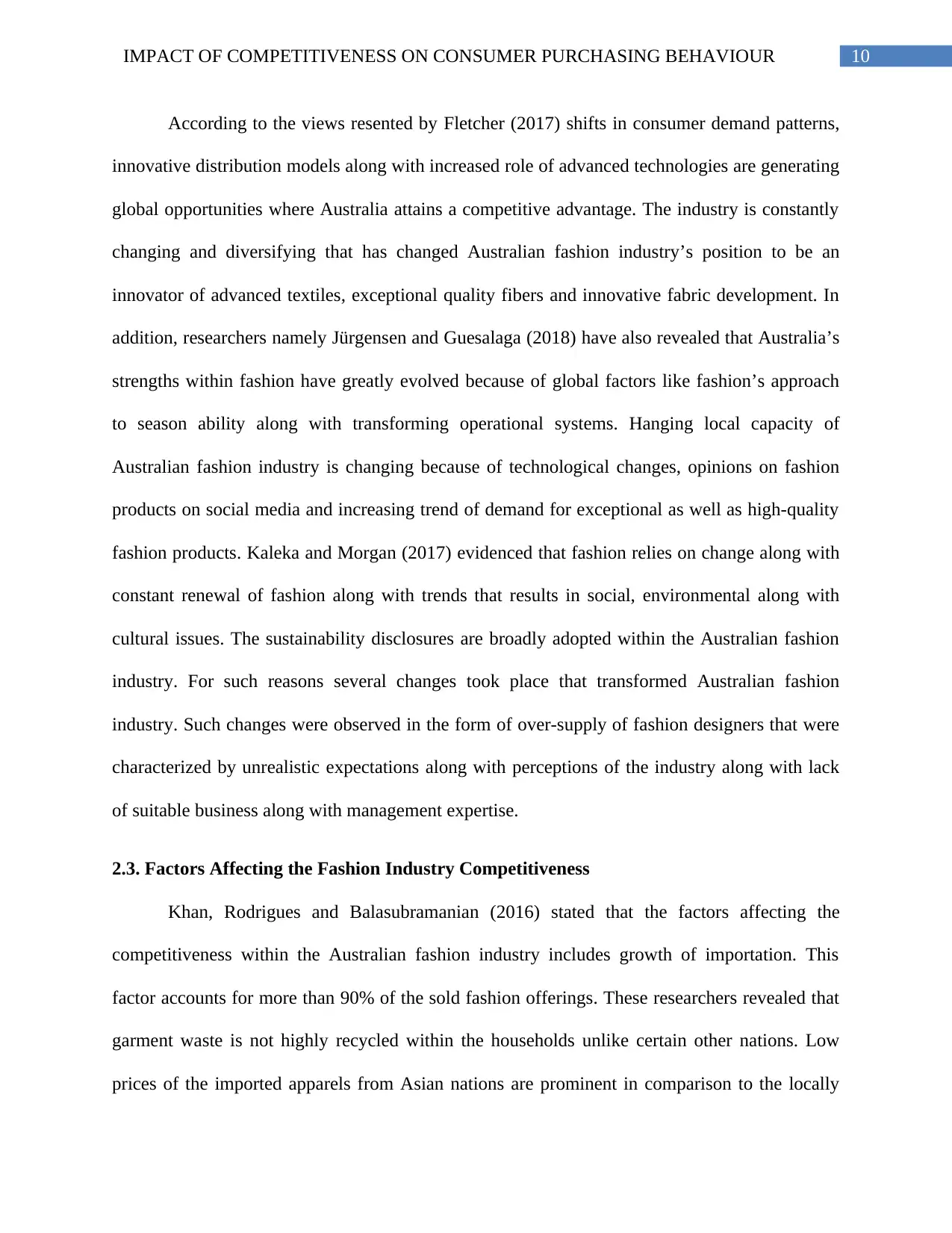
10IMPACT OF COMPETITIVENESS ON CONSUMER PURCHASING BEHAVIOUR
According to the views resented by Fletcher (2017) shifts in consumer demand patterns,
innovative distribution models along with increased role of advanced technologies are generating
global opportunities where Australia attains a competitive advantage. The industry is constantly
changing and diversifying that has changed Australian fashion industry’s position to be an
innovator of advanced textiles, exceptional quality fibers and innovative fabric development. In
addition, researchers namely Jürgensen and Guesalaga (2018) have also revealed that Australia’s
strengths within fashion have greatly evolved because of global factors like fashion’s approach
to season ability along with transforming operational systems. Hanging local capacity of
Australian fashion industry is changing because of technological changes, opinions on fashion
products on social media and increasing trend of demand for exceptional as well as high-quality
fashion products. Kaleka and Morgan (2017) evidenced that fashion relies on change along with
constant renewal of fashion along with trends that results in social, environmental along with
cultural issues. The sustainability disclosures are broadly adopted within the Australian fashion
industry. For such reasons several changes took place that transformed Australian fashion
industry. Such changes were observed in the form of over-supply of fashion designers that were
characterized by unrealistic expectations along with perceptions of the industry along with lack
of suitable business along with management expertise.
2.3. Factors Affecting the Fashion Industry Competitiveness
Khan, Rodrigues and Balasubramanian (2016) stated that the factors affecting the
competitiveness within the Australian fashion industry includes growth of importation. This
factor accounts for more than 90% of the sold fashion offerings. These researchers revealed that
garment waste is not highly recycled within the households unlike certain other nations. Low
prices of the imported apparels from Asian nations are prominent in comparison to the locally
According to the views resented by Fletcher (2017) shifts in consumer demand patterns,
innovative distribution models along with increased role of advanced technologies are generating
global opportunities where Australia attains a competitive advantage. The industry is constantly
changing and diversifying that has changed Australian fashion industry’s position to be an
innovator of advanced textiles, exceptional quality fibers and innovative fabric development. In
addition, researchers namely Jürgensen and Guesalaga (2018) have also revealed that Australia’s
strengths within fashion have greatly evolved because of global factors like fashion’s approach
to season ability along with transforming operational systems. Hanging local capacity of
Australian fashion industry is changing because of technological changes, opinions on fashion
products on social media and increasing trend of demand for exceptional as well as high-quality
fashion products. Kaleka and Morgan (2017) evidenced that fashion relies on change along with
constant renewal of fashion along with trends that results in social, environmental along with
cultural issues. The sustainability disclosures are broadly adopted within the Australian fashion
industry. For such reasons several changes took place that transformed Australian fashion
industry. Such changes were observed in the form of over-supply of fashion designers that were
characterized by unrealistic expectations along with perceptions of the industry along with lack
of suitable business along with management expertise.
2.3. Factors Affecting the Fashion Industry Competitiveness
Khan, Rodrigues and Balasubramanian (2016) stated that the factors affecting the
competitiveness within the Australian fashion industry includes growth of importation. This
factor accounts for more than 90% of the sold fashion offerings. These researchers revealed that
garment waste is not highly recycled within the households unlike certain other nations. Low
prices of the imported apparels from Asian nations are prominent in comparison to the locally
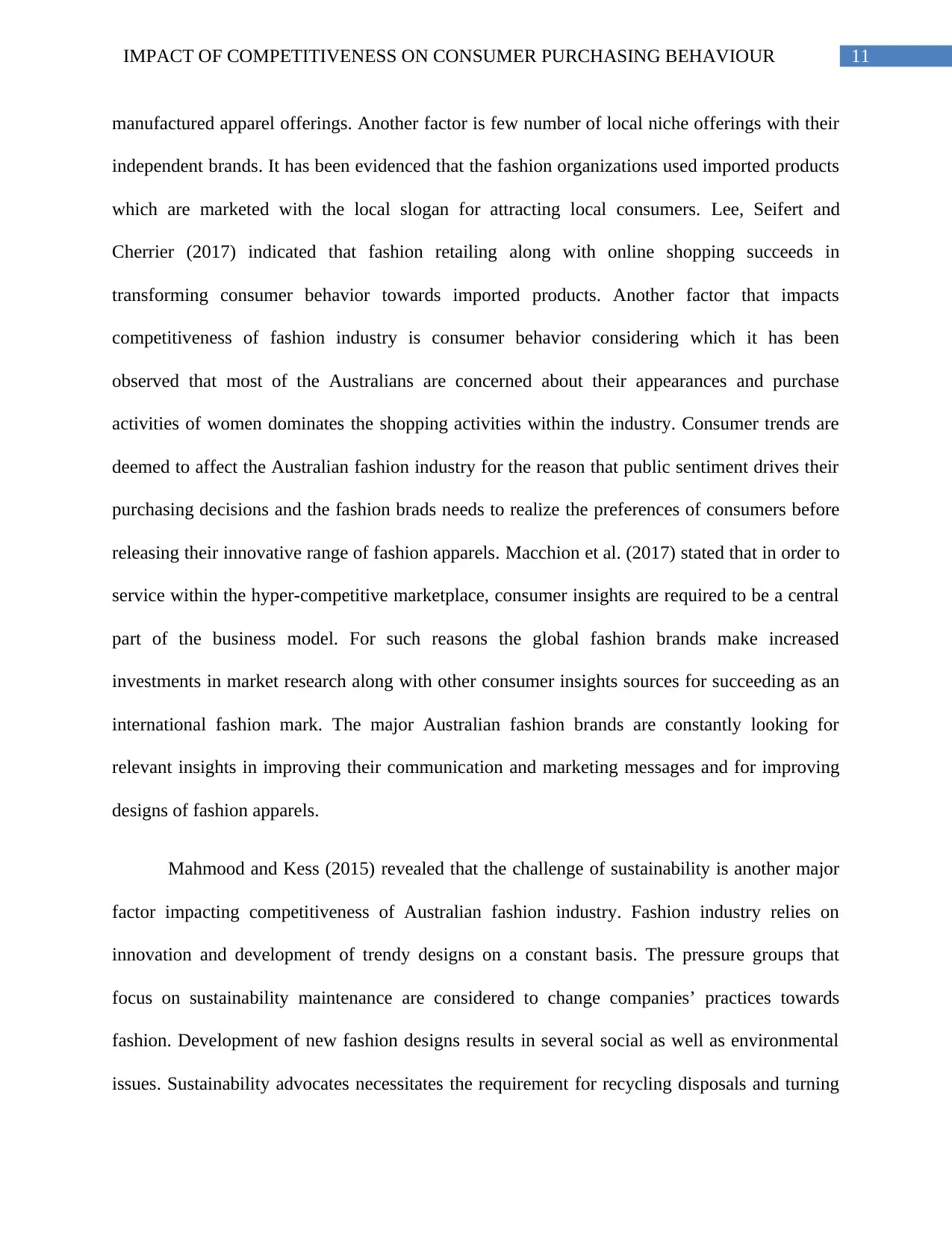
11IMPACT OF COMPETITIVENESS ON CONSUMER PURCHASING BEHAVIOUR
manufactured apparel offerings. Another factor is few number of local niche offerings with their
independent brands. It has been evidenced that the fashion organizations used imported products
which are marketed with the local slogan for attracting local consumers. Lee, Seifert and
Cherrier (2017) indicated that fashion retailing along with online shopping succeeds in
transforming consumer behavior towards imported products. Another factor that impacts
competitiveness of fashion industry is consumer behavior considering which it has been
observed that most of the Australians are concerned about their appearances and purchase
activities of women dominates the shopping activities within the industry. Consumer trends are
deemed to affect the Australian fashion industry for the reason that public sentiment drives their
purchasing decisions and the fashion brads needs to realize the preferences of consumers before
releasing their innovative range of fashion apparels. Macchion et al. (2017) stated that in order to
service within the hyper-competitive marketplace, consumer insights are required to be a central
part of the business model. For such reasons the global fashion brands make increased
investments in market research along with other consumer insights sources for succeeding as an
international fashion mark. The major Australian fashion brands are constantly looking for
relevant insights in improving their communication and marketing messages and for improving
designs of fashion apparels.
Mahmood and Kess (2015) revealed that the challenge of sustainability is another major
factor impacting competitiveness of Australian fashion industry. Fashion industry relies on
innovation and development of trendy designs on a constant basis. The pressure groups that
focus on sustainability maintenance are considered to change companies’ practices towards
fashion. Development of new fashion designs results in several social as well as environmental
issues. Sustainability advocates necessitates the requirement for recycling disposals and turning
manufactured apparel offerings. Another factor is few number of local niche offerings with their
independent brands. It has been evidenced that the fashion organizations used imported products
which are marketed with the local slogan for attracting local consumers. Lee, Seifert and
Cherrier (2017) indicated that fashion retailing along with online shopping succeeds in
transforming consumer behavior towards imported products. Another factor that impacts
competitiveness of fashion industry is consumer behavior considering which it has been
observed that most of the Australians are concerned about their appearances and purchase
activities of women dominates the shopping activities within the industry. Consumer trends are
deemed to affect the Australian fashion industry for the reason that public sentiment drives their
purchasing decisions and the fashion brads needs to realize the preferences of consumers before
releasing their innovative range of fashion apparels. Macchion et al. (2017) stated that in order to
service within the hyper-competitive marketplace, consumer insights are required to be a central
part of the business model. For such reasons the global fashion brands make increased
investments in market research along with other consumer insights sources for succeeding as an
international fashion mark. The major Australian fashion brands are constantly looking for
relevant insights in improving their communication and marketing messages and for improving
designs of fashion apparels.
Mahmood and Kess (2015) revealed that the challenge of sustainability is another major
factor impacting competitiveness of Australian fashion industry. Fashion industry relies on
innovation and development of trendy designs on a constant basis. The pressure groups that
focus on sustainability maintenance are considered to change companies’ practices towards
fashion. Development of new fashion designs results in several social as well as environmental
issues. Sustainability advocates necessitates the requirement for recycling disposals and turning
⊘ This is a preview!⊘
Do you want full access?
Subscribe today to unlock all pages.

Trusted by 1+ million students worldwide
1 out of 49
Related Documents
Your All-in-One AI-Powered Toolkit for Academic Success.
+13062052269
info@desklib.com
Available 24*7 on WhatsApp / Email
![[object Object]](/_next/static/media/star-bottom.7253800d.svg)
Unlock your academic potential
Copyright © 2020–2025 A2Z Services. All Rights Reserved. Developed and managed by ZUCOL.





